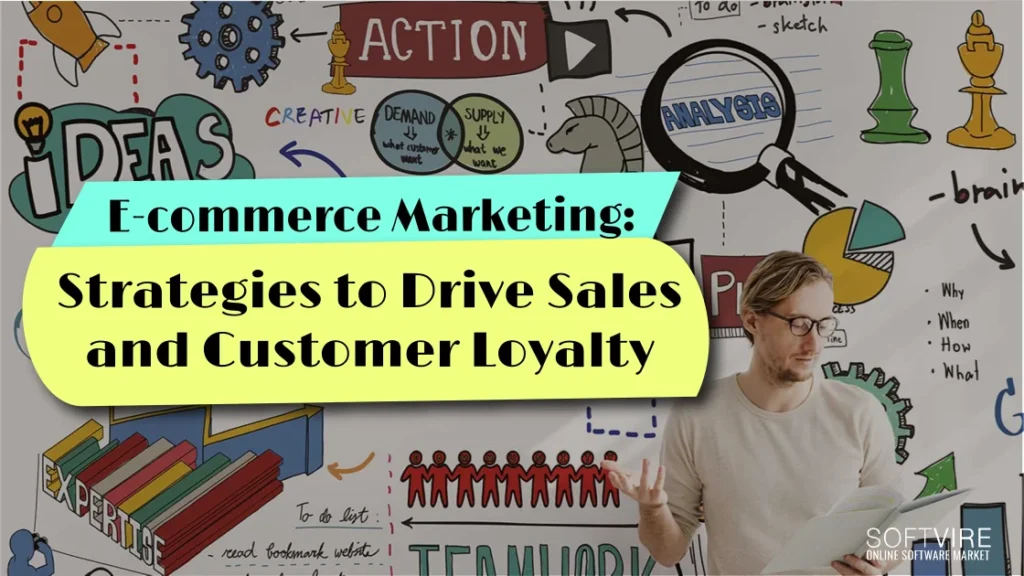I. Introduction
A. Definition of e-commerce marketing
E-commerce marketing refers to enterprises’ strategies and tactics to market their products or services, attract customers, and drive sales in the online marketplace.
B. Importance of driving sales and customer loyalty in e-commerce
Driving sales and fostering customer loyalty is crucial for the success and growth of e-commerce businesses. It helps generate revenue, build a loyal customer base, and achieve long-term sustainability.
C. Overview of the challenges faced in e-commerce marketing
The world of e-commerce marketing is highly competitive, and businesses face various challenges, such as increasing customer acquisition costs, high cart abandonment rates, and the need to differentiate themselves from competitors. This section provides an overview of these challenges and sets the stage for the strategies to overcome them.
II. Understanding the Target Audience
A. Market research and customer representation
are essential to gain insights into the target audience, demographics, preferences, and shopping behaviors. Through thorough market research, businesses can understand their customers’ needs and desires and tailor their marketing strategies accordingly. Customer segmentation further helps categorize customers into specific depending on various parameters such as demography, psychographics, and purchasing behavior.
B. Creating buyer personas for effective targeting
Buyer personas are fictitious depictions of ideal customers. This section explains the importance of creating buyer personas and guides how to develop them. By understanding the needs, motivations, and pain points of different buyer personas, businesses can personalize their marketing messages and offerings to resonate with specific target audiences.
C. Analyzing customer behavior and preferences
Analyzing customer behavior and preferences involves using tools like web analytics, heatmaps, and user feedback to discover how customers interact with the website, what products they are interested in, and their purchasing patterns. This data helps identify trends, optimize marketing strategies, and enhance customer experience.
III. Building a Strong Brand Identity
A. Developing a compelling brand story and value proposition
For e-commerce, a strong brand identity is essential. This section explores the importance of developing a compelling brand story and value proposition. It delves into how businesses can articulate their unique selling proposition, brand values, and brand promise to connect with customers on a deeper level.
B. Creating a consistent brand image across all touchpoints
Consistency is essential for developing a solid brand image. This subsection explains the significance of maintaining a consistent brand image across various touchpoints, such as the website, social media platforms, packaging, and customer interactions. It emphasizes the need to use consistent branding elements, messaging, and tone of voice to create a cohesive and recognizable brand.
C. Establishing brand trust and credibility
Trust and credibility are vital for e-commerce success, as customers must feel confident in their purchasing decisions. This section discusses strategies to establish brand trust and credibility, such as showcasing customer testimonials, displaying trust seals and certifications, providing transparent product information, and offering secure payment options. By building trust, businesses can differentiate themselves from competitors and foster customer loyalty.
VI. Pay-Per-Click (PPC) Advertising
A. Setting up effective PPC campaigns on search engines and social media platforms
This subsection delves into setting up PPC campaigns on popular search engines like Google and social media platforms like Facebook and Instagram. It discusses the importance of selecting relevant keywords, targeting specific demographics, and setting appropriate bidding strategies to maximize the effectiveness of PPC advertising.
B. Conducting a keyword research for PPC ad targeting
Keyword research is equally essential for PPC advertising as it helps identify the keywords that potential customers are searching for. This section explains the process of conducting keyword research specifically for PPC campaigns and provides tips for selecting high-performing keywords with the right search volume and competition level.
C. Creating compelling ad copy and landing pages
Compelling ad copy and landing pages are crucial for driving conversions in PPC campaigns. This subsection explores strategies for creating persuasive ad copy that captures attention and encourages clicks. It also highlights the importance of designing optimized landing pages that align with the ad copy and provide a seamless user experience, leading to higher conversion rates.
VII. Content Marketing
A. Creating high-quality and engaging content
Content marketing plays a significant role in e-commerce marketing. This section emphasizes the importance of creating high-quality, engaging content that provides value to the target audience. It discusses various content formats, such as blog posts, videos, infographics, and product guides, and provides tips for crafting compelling content that resonates with customers.
B. Incorporating storytelling and visual elements
Storytelling and visual elements are powerful tools in content marketing. This subsection explores storytelling techniques to connect emotionally with customers and effectively communicate the brand’s message. It also emphasizes the importance of incorporating visual elements like images, videos, and graphics to enhance engagement and convey information more effectively.
C. Leveraging different content formats
Diversifying content formats is essential to cater to different audience preferences. This section discusses the importance of leveraging various content formats based on the target audience’s preferences and the nature of the product or service. It emphasizes the advantages of combining blog entries, videos, infographics, and user-generated content to keep the audience engaged and interested.
VIII. Social Media Marketing
A. Choosing the right social media platforms
This subsection discusses the importance of selecting the appropriate social media platforms based on the target audience’s demographics, preferences, and behavior. It explores popular platforms such as Facebook, Instagram, Twitter, LinkedIn, and Pinterest and provides insights into their unique features and audience characteristics.
B. Developing a social media content strategy
Developing a comprehensive social media content strategy is crucial for successful e-commerce marketing. This section explains the critical components of a social media content strategy, including content planning, creation, and scheduling. It highlights the importance of aligning social media content with brand identity and marketing objectives.
C. Engaging with the audience and fostering community
Engagement and community building are integral parts of social media marketing. This subsection explores strategies for engaging with the audience through interactive content, responding to comments and messages, and fostering a sense of community. It emphasizes building meaningful customer connections to drive loyalty and advocacy.
IX. Email Marketing
A. Building an email list and segmenting subscribers
Building an email list and segmenting subscribers is essential for targeted and effective email marketing campaigns. This section discusses strategies for building an email list through website opt-ins, lead magnets, and social media promotions. It also explores the importance of segmenting subscribers based on demographics, purchase history, and engagement level to deliver personalized and relevant email content.
B. Crafting compelling email campaigns
Crafting compelling email campaigns is crucial for driving sales and customer loyalty. This subsection provides tips for creating engaging email content, including promotional offers, product recommendations, personalized messages, and valuable content. It emphasizes optimizing email design, subject lines and calls to action to maximize open and click-through rates.
C. Automating email workflows and nurturing customer relationships
Automating email workflows and nurturing customer relationships through automated email sequences are efficient and effective strategies. This section explores the concept of email automation and discusses how businesses can set up workflows for welcome emails, abandoned cart reminders, post-purchase follow-ups, and re-engagement campaigns. It emphasizes the importance of delivering relevant content at the right time to nurture customer relationships.
X. Customer Retention and Loyalty Programs
A. Implementing customer retention strategies
This subsection discusses the significance of customer retention strategies in e-commerce marketing. It explores tactics such as personalized recommendations, exclusive offers, loyalty rewards, and excellent customer service. It emphasizes the importance of fostering long-term relationships with existing customers to drive repeat purchases and customer loyalty.
B. Creating a customer loyalty program
Customer loyalty programs are practical tools for incentivizing repeat purchases and building brand advocates. This section provides insights into creating a customer loyalty program that offers loyal customers rewards, discounts, or exclusive perks. It discusses program structures, points systems, and the benefits of fostering a loyal customer base.
C. Monitoring and optimizing customer retention efforts
Monitoring and optimizing customer retention efforts are essential for continuous improvement. This subsection explores the importance of tracking Customer lifetime value, retention rate, and other crucial metrics and repeat purchase rate. It discusses using data analytics to gain insights into customer behavior, preferences, and satisfaction levels. It highlights the significance of making data-driven decisions to optimize customer retention strategies.
Conclusion
In conclusion, effective e-commerce marketing strategies drive sales and foster customer loyalty. Businesses may effectively communicate with customers and maximize their online presence by understanding the target audience, building a solid brand identity, optimizing the e-commerce website, and leveraging various marketing channels.
Through strategies such as SEO, PPC advertising, Customer retention programs, content marketing, social media marketing, and email marketing, businesses can attract, convert, and retain customers in the competitive e-commerce landscape.
Continuous monitoring, analysis, and optimization of marketing efforts are essential for long-term success and growth in the e-commerce industry.
Check out the different Microsoft software products today if you need trusted software that uses AI ethically and efficiently. They continue to lead in using AI for their many office tools like Office 365. Get discounted Office 365 in Canada now!



